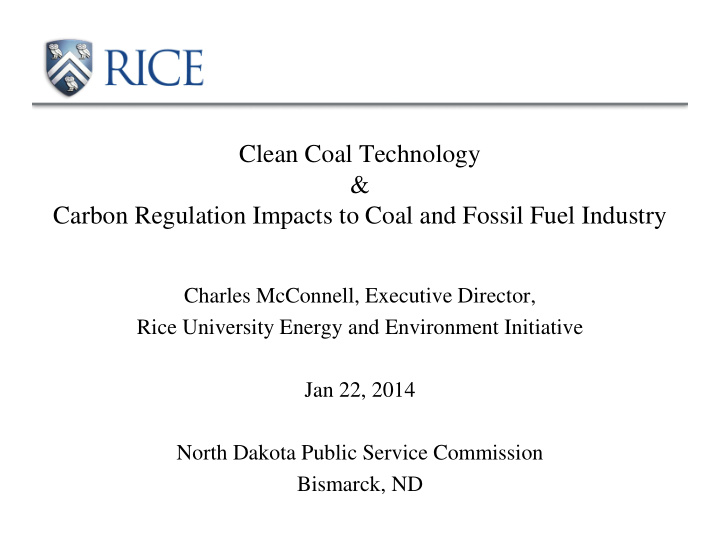



Clean Coal Technology & Carbon Regulation Impacts to Coal and Fossil Fuel Industry Charles McConnell, Executive Director, Rice University Energy and Environment Initiative Jan 22, 2014 North Dakota Public Service Commission Bismarck, ND
Overview • Global Perspective – Energy and Environment Sustainability • Clean Coal Technology – “CCUS” – CO 2 capture – Geologic research – EOR and transformative potential • Regulatory Landscape for Power Industry – New coal-fired plants - NSPS – Existing coal-fired plants – Fossil fuel CO 2 future and EOR • North Dakota and Critical Leadership for Transformation
Global Perspective • World’s Energy Demand Will Increase 100% by 2050 per the International Energy Agency (IEA) • Growth Will be Driven By – Aspiration to eliminate energy poverty – 1.4B people – Unconventional industrial and consumer demand • Energy Security is the Driving Force • All of the Above must be the Energy Strategy • By 2050, 85% of World’s Energy will be Fossil Fuel
Carbon Capture Utilization & Storage • What is CCUS? and Why is the “U” So Critical for Fossil Fuels Global Adoption and Sustainability? • CO 2 Capture Technologies – Demonstration plants and current projects – 2 nd generation technology by 2020 > $40-60/ton CO 2 * – Transformative technology by 2030 > $10-20/ton CO 2 * • Geologic Research – Regional carbon sequestration partnerships in US – Global interest – CCUS is the answer – 100+ years of potential *DOE targets per CCUS R&D Roadmap
Regulatory Landscape • New Source Performance Standards – NSPS • Existing Coal and Fossil Plants on Horizon • CO 2 Research and EPA Regulations – Class VI • CO 2 EOR and Class II Regulations Must Support Both Energy and Environment Sustainability and Facilitate Market Realization and Deployment for Impact
Bakken The more we understand, the • more oil and potential we see Currently, only a 3 – 10% • recovery factor Small improvements in • recovery could yield over a billion barrels of oil • Will CO 2 be a game changer in the Bakken? – For business – For the environment
EOR Potential • Significant Non-Bakken ND Fields/Pools Await CO 2 EOR • Nearly 130 million tons of CO 2 needed for the top 22 candidate fields in ND
How Many More Bakkens?
CO2 & EOR in North Dakota • Bakken CO 2 Demand for ND – A 30,000 Feet View • Based on the following: – Traditional evaluation techniques – ND Industrial Commission original oil in place estimates – 4% incremental recovery – Net utilization of 5 and 8 mcf/bbl • 2 to 3.2 billion tons of CO 2 needed • ND currently produces ~33 million tons of CO 2 /year
Recommend
More recommend